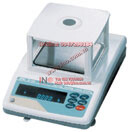SR124 Analog Lock-In Amplifier
For over a half century, the lock-in amplifier has been the instrument of choice for measuring small AC signals in the presence of noise. Early instruments were designed with analog electronics, multi-gang mechanical switches, needle indicators, etc., and measurements were often monitored with chart recorders. Microprocessor based designs emerged in the 1980s, and by the early 1990s even the lock-in’s analog demodulators were replaced by high-resolution ADCs and digital signal processors (DSP). Remote computer control, digital readouts and user-friendly front panels all resulted.
The capabilities of the modern DSP lock-in amplifier in stability, dynamic reserve, and flexibility were revolutionary, making it a mainstay for researchers and engineers across multiple fields. But in moving forward, something was left behind. For a core group of users, including low-temperature researchers in particular, the new instruments became a potential source of high-frequency interference. This is best reflected in the persistence of one instrument — the PAR124A — still actively used by many researchers decades after discontinuation by its long-gone manufacturer.
Back to Analog
Recognizing that one size shouldn’t have to fit all, SRS is proud to introduce the SR124 Analog Lock-In Amplifier. Inspired by the best of an earlier generation’s lock-ins, but availing itself of today’s low-noise analog components and design methodologies, the SR124 is an uncompromising tour de force in low-noise, high-performance analog instrumentation.
Architecture
The SR124 design follows two basic themes. First, the signal path is entirely built from low-noise analog electronics: the best JFETs, transistors, op-amps, and discrete components. Second, configuration control is managed by a microcontroller whose system clock only oscillates during the brief moments needed to change gains or filter settings. This “clock-stopping” architecture, first introduced by SRS in the SR560 Voltage Preamplifier, eliminates the inconvenience and reliability issues associated with mechanical panel controls, and makes full remote operation of the SR124 possible.
Don’t let the numeric displays fool you — the SR124 really stops all digital clocks during operation. The numeric displays show precision setting information, such as input filter frequency, demodulator phase shift, and source output amplitude. The drive electronics are completely static, with no “scanning” or refresh to generate the slightest interference.
Whenever the microcontroller becomes active, the “CPU Activity” indicator illuminates, clearly showing when the digital clock is running. This occurs in response to front-panel button presses or remote computer commands.
When it Really Matters — Run Silent!
Sometimes, you need to be confident your experiment will be undisturbed: you’ve cooled your sample to a few millikelvin, all your wiring is still intact, and the best device you’ve built all year is ready for measurement. A locking toggle switch on the front panel can be set to “LOCKED OUT”, forcing the digital clock to remain off, even if you press other buttons or knobs. The analog configuration of the SR124 stays steady, letting you run for minutes, hours, days — as long as you need.
Low Noise Input Amplifiers
The SR124 has both voltage and current inputs. The voltage input is a single-ended/differential FET preamp with ultra-low 2.5 nV/√Hz input noise. The input impedance is 10 MΩ, and minimum full-scale input voltage sensitivity is 100 nV. The current input preamp has selectable gains of 106 and 108 V/A. Both AC and DC coupling is provided, and the instrument can operate in Ground or Float mode.
SRS also makes a variety of remote preamplifiers including the SR550 (FET input), SR552 (BJT input) and SR554 (transformer input) which can all be powered directly from the SR124’s rear-panel preamp power port. These preamplifiers have unique characteristics which are optimized for a variety of experimental conditions. When used with the SR124, they can often significantly improve your measurements.
Input Filters
The SR124 provides several filter types for preconditioning your signal before it reaches the phase-sensitive detector. A choice of flat (no filtering), band pass, high pass, low pass, and notch filtering can be selected, and the Q-factor for the filter can be set between 1 and 100.
In band pass mode, a tunable narrow-band amplifier rejects signals outside of the passband, providing as much as an additional 60 dB of dynamic reserve.
The high pass and low pass filters allow you to limit the band of frequencies presented to the lock-in amplifier, and reject frequencies outside of the passband. The rolloff for these filters is –12 dB per octave.
In notch mode, a tunable band reject filter is engaged that provides up to 80 dB attenuation at a particular frequency.
Dynamic Reserve
The dynamic reserve of a lock-in amplifier, at a given full-scale input sensitivity, is the ratio of the largest interfering signal to the full-scale input voltage. The largest interfering signal is defined as the amplitude of the largest signal at any frequency that can be applied to the input before the lock-in cannot measure a signal with its specified accuracy.
The SR124 has a dynamic reserve of up to 60 dB, depending on the sensitivity setting and the reserve mode. Engaging the input band pass filter can add an additional 20 to 60 dB of dynamic reserve, making the maximum achievable dynamic reserve 100 dB.
Output Time Constants
The SR124 offers two stages of output low pass filtering. Time constants can be chosen as long as 300 s for maximum noise reduction, or as short as 1ms. A choice of –6 dB or–12 dB per octave rolloff is selectable. The Minimum time constant setting bypasses the output filter, and the output signal bandwidth is simply determined by internal stray capacitance.
Offset
The SR124’s offset feature makes it easy to evaluate small changes in the presence of a full-scale signal. You can adjust the offset manually between ±1000 % (10×) of full-scale, or you can use the auto-offset feature to set the offset equal to the signal value with the push of a button. Once the offset has been adjusted, you can add gain (up to 10×) by decreasing the sensitivity setting.
Auto Features
Convenient auto features allow you to quickly configure the SR124 to optimum settings. Pressing the Gain, Phase, or Offset buttons starts the microcontroller, which then adjusts the instrument for either best sensitivity (Gain), phase shift to maximize signal (Phase), or null the output (Offset). The Ref Range button toggles the frequency auto-ranging feature on and off, which allows the SR124 to automatically set the appropriate reference range whenever the oscillator unlocks.
Reference Channel
There are three reference modes in the SR124: Internal, External, and Rear VCO. In all modes, the frequency range is first chosen in the reference section of the front panel — either manually or by the auto Ref Range feature.
In external reference mode, the SR124 will lock to external signals with at least 100 mVpp amplitude. The reference oscillator will phase-lock to the positive zero-crossings of the external reference input. Locking at f, 2f (second harmonic), or 3f (3rd harmonic) is supported.
Operated in internal mode, the reference frequency is set from the front panel with ±0.1 % accuracy. In addition to internal and external reference modes, the SR124 also has a built-in voltage controlled oscillator (VCO) that can be the lock-in’s reference. The rear-panel VCO input accepts a 0 to +10 VDC signal which corresponds to the lowest and highest frequencies in the range set on the front panel. This convenient feature allows you to lock the SR124 to a variable or swept control voltage.
A synchronous reference output signal is always present at the front-panel Ref Out BNC connector. Both sine and square waveforms are selectable, and the output amplitude can be set between 100 nV and 10 V. The reference is also available on the rear panel of the SR124. Four phase-shifted 1 Vrms outputs at 0°, 90°, 180° and 270° can used for a variety of applications.
DC Bias
The SR124 introduces a new feature to the traditional reference output signal of the lock-in amplifier. A bipolar DC bias voltage, independent of the AC reference amplitude, can be added to the reference output by switching “DC Bias” on. This feature is particularly helpful when making differential conductance and related transport measurements, where the small-signal AC response of your experiment must be measured at a range of different bias values. Bias values can be set up to ±1000× the reference amplitude, depending on amplitude.
Phase Control
The SR124 is a single phase lock-in amplifier, so the phase of the reference will often need to be adjusted. Manually nulling the phase is easy—press the phase button and turn the large knob until the signal is nulled, then shift the phase by 90°. Or, simply press the auto Phase button. The phase resolution is 0.01°, and phase accuracy is ±1° at mid-band frequencies.
AC Voltmeter Mode
For most applications, the SR124 will typically be operated in Lock-In mode, but the mode can be changed to AC Volt allowing the SR124 to operate as a wideband or frequency selective AC voltmeter. In this mode, the average absolute value of an AC signal can be quickly measured without the need for a reference signal.
Computer Control
For those who need computer control of their lock-in amplifier, there is an RS-232 interface on the rear panel of the SR124. All functions of the instrument can be set or read via the interface. When sending commands to the instrument, the SR124’s microcontroller will be activated, and digital noise may be present. During these times, the front-panel Remote Activity LED alerts you that communications are taking place.
For remote interfacing with complete electrical isolation, the SR124 also has a rear-panel fiber optic interface. When connected to the SX199 Remote Computer Interface Unit, this provides a path for controlling the SR124 via GPIB (IEEE-488.2), Ethernet, and RS-232.




















